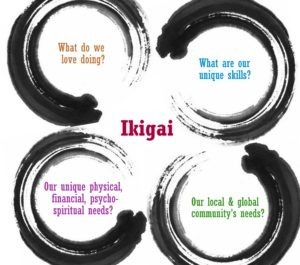Ecodharma friends
Please know that Kritee has interchangeably referred to this article as “Islands of Belonging friendships” “Ecodharma friendships” or “Ecodharma pods”. This article was written several years before she started working on her book with a vision of having humans become keystone species.
In the Buddhist perspective, our world, all species, people from all racial, religious or economic backgrounds and all things are really our own larger bodies. Buddhists even have a phrase for this interconnected and interdependent reality or larger body: Interbeing. What does an Ecodharma community look like when its members are rooted in spirituality/dharma and also want to take actions together in the service of not just our immediate friends and family but our larger body?
A few common features of all friendships include 1) empathy, an ability to put ourselves in the shoes of a friend and to be able to honor their emotional landscape; 2) the ability to create safe, trusting and joyous spaces for our friends; and 3) mutual trusting permission to co-create our life. So then, how would friendships of people interested in both dharma and outer action be different from family or spiritual friendships we usually encounter in our modern world?

Families and modern friendships, at the very least, help us navigate or control our lives at an operational level. They help us raise our children, work towards a promising career or maintain a safe or beautiful home: they might share their life experiences and recommend the right nanny, soccer-teacher, plumber, life-coach, doctor, architect or lawyer. After a stressful week, they might help us chill out and unwind at a bar or a restaurant. If their busy life allows, they could join us for a movie or help us celebrate our togetherness. If we are feeling sad or sick and if they are inclined towards paying attention to lifestyle choices, they will cook a healthier meal for us (or share healthy recipes with us) and encourage us to hit the gym, take up yoga or jogging or even camp out in the nature from time to time. If they are an avid reader and interested in international or domestic politics, interactions with them might involve heated discussions about the state of the world.
Overall, if they have skills in the area of our life where we are stuck, they help us control stressful situations or their effect on us by offering their help, support and advice.
Spiritual friendships include a wider range of responses to our life situations as compared to usual responses from our friends. The primary purpose of spiritual friendships is to help us face our inner (subconscious or unconscious) realities behind our actions and emotions, and help release and transform hard emotions that are stuck in our mind-body-heart. Spiritual friends might see patterns in our behavior that we can’t see ourselves: they can help us find ways to explore deeply what causes our stress and to be fully honest with ourselves. The actual nature of response would, of course, depend on the stage of inner growth of people involved as well as on the space in which our interactions occur (the engagement and transformation that happens during a one-to-one conversation in a quiet space will be different from what happens in a group during a potluck meal).
Yes, the response of a spiritual friend might include offering ways to help us control our lives. Typically, however, a spiritual friend would focus on encouraging us to patiently engage in inner work that is necessary to be OK (or even effortlessly easy, trusting and patiently energized) in the midst of uncontrollable, complex, and unpredictable situations in our lives. At the deepest level, spiritual friendships help us discover and stay connected with the “Boundless” which manifest itself as trust, gratitude, compassion and inter-connectedness. This “inner” boundlessness can 1) hold our anxieties in itself and illuminate patterns that cause these anxieties; 2) help us see that everyone and everything is co-creating whatever happens and 3) inspire our continuous “outer” work towards a equal, just and free culture while letting go of our expectations.
More often than not, uncontrollable situations that are stressful for us include fear or reality of sickness, old age, death and changes in our jobs, relationships or living situations. A spiritual friend or mentor’s primary task is to help us find or follow a path where we can repeatedly face our inner ghosts and hindrances without distractions (they will offer to meditate with us or encourage us to see a wise and kind therapist or share news of a residential contemplative or mind-body retreat). Usually, inner work requires a steady combination of determination, faith and genuine curiosity and spiritual communities provide a space where this combination is honored and celebrated.
Friendships within an “Island of Belonging” community, in my view, will involve even a wider range of responses than from spiritual friends in the West. Such friends will create a culture where our responses to disagreeable external circumstances include 1) “inner” work on our psycho-spirituality, 2) study of the deep and root institutional (economic, educational, religious, media and militaristic) causes that have led to those circumstances including trauma, white supremacy, relationships between different actions as well as the ways in which we as individuals are participating in those institutions and 3) creative, strategic passionate and collective action that can midwife a more healthy, simpler, more equal, just and free community/society without egotistical attachment to some fixed goals.
A third pillar is important: What would be the aim of collective action taken by practice circles?
A general goal that all practice circles might work on is reducing our carbon and ecological footprint. For example, an average American emits 30,000 Kg (or 65000 lbs) of carbon dioxide in one year as compared to the goal of 1500 Kg (or 3300 lbs) every year that is necessary to meet the global goal of staying below 2 degree Celsius change in average global annual temperature. This goal of reducing our carbon footprint in accordance with what scientists say is needed is going to be extremely hard for Americans and cannot to be done without creating a shared and simpler life!
A more specific example of a “third pillar” action, if a child in the community has chronic asthma, a loving community will create a space where we can share and release our fears and pain. They might meditate with us over the longer term and help us access deeper layers of consciousness so that we are really okay (or even trusting and joyous) amidst the uncontrollable sickness of our beloved child. It will also, slowly and surely, work with us to identify deepest possible systematic reasons air pollution has not yet been controlled. And then, it will help us transform our love for our child into energetic, wholesome and collective action to restore air quality without paralyzing denial, confusion or fear.
An Ecodharma community/pod will inspire us to continue patient and passionate engagement with complex problems even when currently no solutions are in sight. Yes, our practice circle friends might want us to install air filters that control purity levels of air in our house to help ease asthma attacks for our kid, but they won’t stop there. The community will also never let us lose sight of the fact that families that are lower on the socio-economic, caste/race or class ladders inhale more polluted air than others. When a community genuinely includes everyone in its circle of fierce compassion irrespective of views, sexual orientation, race, caste, religion or species, our individual grief and anxiety merges with the “river of grief and anxiety” that exists in the homes and lives of millions of families across the world. This sense of deep interconnection naturally aids our actions and increases the probabilities of positive outcomes.
It is possible that there aren’t too many communities of practice (or pods) amidst us today that fulfill all of these functions and that this vision is somewhat idealistic. Perhaps some communities are more inclined towards spirituality (dharma) and will mostly help to create spaces where we can do our inner work. Some groups might take on the task of helping us think through about the interconnected roles played by institutions in creating our society. And yet another set of communities might be built around providing us with ways to deeply and collectively feel, express and honor our emotions around ecological and societal crisis (that might include grief, anger, confusion, guilt or shame). As outlined in the description of Three pillars of Ecodharma, however, the coming together of these different strands within a single community could be extremely powerful. When the basis of our intellectual discernment of the root causes of institutional injustices and action is deep inter-connection, clarity and spiritual power, it is healing and transformative, both for the members of that community as well as the larger society as a whole.
We might do well in our lives with a few selected friends and families helping us navigate our lives. However, the truth of ongoing ecological devastation, psychological isolation/trauma, white supremacy and climate crisis and growing socio-economic inequalities that threaten well being of current and future generations requires communities that will together look at everything described above. Without our constant inner work to realize both our spiritual interconnection or sisterhood with each other and our inherent unity with the ground of being (call it “God”, “Tao”, “Big Mind”, “Nirvana” or “Cosmic light”), and without that inherent unity inspiring our personal and collective strategic participation, we will not be able to patiently face or change complex realities of our times.

Ikigai: An important feature of a community that is cultivating belonging would be paying attention to vocations of individual members. We have identified that a crucial basis of “Islands of Belonging” practice circles should be what is called Ikigai is Japanese: it means “Reason of being” and is known to be at the interface of what we love, what we are skilled at, what the world needs and what we need to sustain ourselves. Through meditation, contemplation, journal-writing and small group discussions, we can uncover what are the elements of our Ikigai. We will also ask how, with support of community members sharing similar Ikigai, can identification of our Ikigai lead to creation of practice group(s) focused on a specific (and hopefully local) “third pillar” issue(s) such as fracking, racism, housing crisis, nuclear arsenal, patriarchy, community resilience, contemplative media, personal lifestyles/footprints and local economies.
So what do you uniquely love and have experience in that can serve your practice circle as well as the larger body in a way that aligns with the Three pillars of Ecodharma (Block Build Be)?
— Kritee (Kanko)
Originally written in 2016, Last updated in July 2020